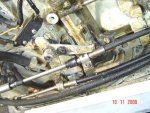These instructions will apply to all three and four cylinder Chrysler one piece lower units, all years, up to all three and four cylinder Force units to 1989. They are all the same design. After 1989, Mercury started to make changes and while the lower units were essentially similar, minor variations were present until Merc completely changed to a Merc midleg and lower unit.
Changing the water pump impeller is easier to do with the engine tilted up.
Below the engine mounting clamps (actually, below the lower engine pivot mount--a plate with 4 bolts holding it) you will see a cylindical shift linkage connector. It will be held with a small pin through it and a smaller cotter pin through the small pin. Pull out the cotter and slip out the pin. The shift linkage is now disconnected.
Now, after noting and marking its position, (because it acts as a trim tab) remove the exhaust snout. It will be held on with a flattened 5/8 inch head bolt just above the propeller. Inside the back of the snout will be either a 1/2 inch hex head or a 3/8 inch socket head cap screw. This holds the back of the snout on.
Up inside the now exposed exhaust cavity you will find the 7th hidden mounting bolt. It will be a 1/2 inch hex head unless it was stripped and re tapped to 3/8 bolt with a 9/16 hex head. Remove it.
Now remove the six (1/2 inch hex head) exposed mounting bolts under the cavitation plate. The lower unit may just slide right down, or it may take a little persuasion with a rubber mallet. The black rubber crankshaft seal will probably come off the top of the drive shaft as well as the steel collar. If they stay up inside the midleg, lower the engine and they should just fall out. If not, tap and jiggle a bit. When you go to replace the lower unit, the collar goes on with the groove facing up and the rubber seal goes on with the beveled end up.
Now you will see the water pump held on by four 7/16 hex head bolts. Remove them--they may be corroded in and will in all probability fight you. Be careful, they are 1/4 inch bolts and are easy to snap. If they are real tight, try rocking them with the wrench, increasing the turning out by about 1/16 - 1/8 turn each rock or twist. Sometimes this keeps them from snapping. Use a green Skotch brite pad to clean the drive shaft. If corrosion is heavy, you may need to use medium sandpaper. Lift off the pump housing and the impeller may or may not come with it. Do not lose the drive key--it is a special one and costs 8 bucks. Check the inside of the housing for heavy corrosion, deep pitting, deep gouges, or excessive wear. Replace if any of these are present. Light scratches and scuffing in the walls are normal and acceptable. (Clymers doesn't tell you this)
You will have previously purchased both an impeller and a gasket that goes under the stainless steel plate below the pump housing. Lift off this plate and the gasket will most likely be damaged. scrape off the old gasket and check the condition of the lower plate (housing). If the passage walls are corroded to the point where the new gasket will not seal them, they will bypass water from the outlet to the inlet and pump efficiency will be reduced. So: if they are well corroded, either repair them with a good epoxy or buy a new lower plate. (Clymers does not tell you this) This plate is kinda pricey because it carries the drive shaft seal, so it is worth a try to repair it if it needs it. (Or this)
Install the new gasket and stainless plate. Install the key and impeller on the shaft. Lubricate the pump housing with dish soap and push it down over the impeller with a counter-clockwise twisting motion. The impeller is larger than the pump housing and the turning sets the impeller blades in the correct direction as they enter the pump housing. (They don't tell you that either.) Now, put anti seize on the bolts so they come out easier next time and hand tighten. Tight--but you don't need to kill them. Too tight and you run the risk of warping the pump housing or stripping the bolt holes. The bolts are going into aluminum.
The lower unit is heavy so if you are not in good physical condition, have someone help to hold the unit while removing and re-installing. They can also help by turning the flywheel to line up the splines. Coat the splines with a light coating of anti-seize--too much is no good; it may pre-load the shaft when assembled in the crank. I also like to coat the whole shaft with anti-seize to help prevent corrosion. I rub it in with a paper towel to assure good adhesion. When re-installing the lower unit, you must feel around to get the drive shaft into the crankshaft splines. Be sure that the brass water tube is seated in the plastic collar on the pump. Then just put everything back together with anti-seize on all bolts. Remember to reconnect the shift rod.























